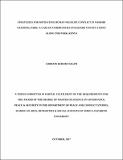Strategies for Mitigating Human Wildlife Conflict in Nairobi National Park: A case of Communities in Kajiado County Living along the Park, Kenya

View/
Date
2017Author
Sagini, Lorrain Kerubo
Type
ThesisLanguage
enMetadata
Show full item recordAbstract
Human wildlife conflict is the interaction between human beings and wildlife and the result in most cases is destructive. It could either be the resources available to human beings are affected or wildlife habitat is affected. Humans and the wildlife have co-existed over a long period of time; however, the problem comes in when human beings encroach into wildlife habitats or wildlife comes into the human land and affects their livelihoods. This has become an emerging issue and may pose a serious challenge in the future if effective strategies are not used. The theory of planned behavior states that behaviors are linked to beliefs, what a person regards as a norm is what they live by. The purpose of this study was to look into the strategies for managing human wildlife conflict and how they can be effective in reducing the escalation of Human Wildlife Conflict. The objectives of this study were to look at the causes of the conflict, the attitude and behavior of the communities living along the park, the role that Kenya Wildlife Service plays in managing the conflict as well as the strategies for mitigating the conflict. A cross sectional descriptive research design was used in the study and a stratified sampling procedure was employed. The target population with a sample size of 204 respondents was the communities living around Nairobi National Park as well as the park employees and a survey was carried out within Kitengela and Rongai wards where they were engaged directly to collect sufficient primary data. A cross sectional descriptive research design was employed where qualitative data and quantitative data were gathered from the field through questionnaires and interviews. The findings from the research revealed that the strategies exist they are however not effective, they further revealed that however much the communities may have interest in conservation they engage in activities that provoke wildlife and they are not well educated on issues of responding to animal attacks. The data obtained was analyzed with the aid of SPSS where the questionnaires were analyzed using descriptive statistics where data was interpreted using frequencies, percentages, mean and standard deviations and the interviews were analyzed through content analysis. Qualitative data was analyzed by sorting and presenting the responses to show the causes, attitude and behavior of the communities, role of KWS in managing the conflict and the strategies for mitigating the conflict. It is therefore recommended that Kenya Wildlife Service fence around the park to ensure that human settlement does not encroach into the park, the people should also limit their activities that provoke the wildlife and also be educated on conservation practices and undergo training on the same in order for them to take part in wildlife conservation and to enable them to own the mitigating strategies to make them effective. It is also important for Kenya Wildlife Service to ensure that the compensation schemes are timely and effective and to ensure that the communities are involved in all activities pertaining conservation; they should also create environmental awareness to enable the communities to put their land to proper use. In conclusion, conflicts in other parks should also be looked into in order to adopt their successful mitigation strategies.
Publisher
Africa Nazarene University
